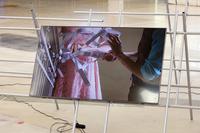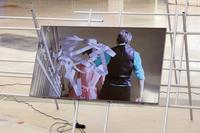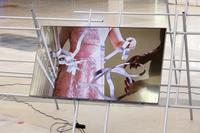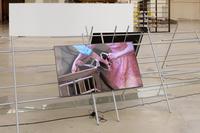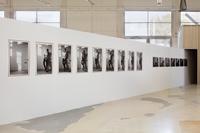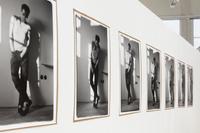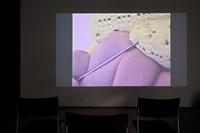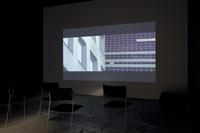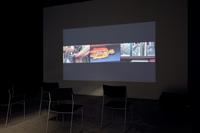Anna Daučíková: Oh and Hah, and Oof. Somewhat More on Pedig\queer/ ree
On kinship, feminism, and disruption of the norms of corporeality. A retrospective series of video performances by the author and new collaboration with Norbert Lacko.
←→
“It’s not about one speaking of oneself but through oneself.”
Anna Daučíková
Anna Daučíková’s work is revealed to us gradually, starting with gender and transgender issues and making it to geometry and optics, thus taking a backward direction in the context of her development as an artist. I first knew her videos in which she explores and questions identity frameworks and determinations incorporated – especially by non-heterogenous people – through upbringing and with violence into pre-prepared social and personal roles (such as Anna’s Portrait of a Women with an Institution, an open cycle she has worked on since 2009 and in which she portrays women but also her relationship to the Roman-Catholic Church). I viewed Anna’s now-iconic glass projects (a photo-performance Upbringing by Touch, 1996) as a conceptual-performative commentary on the restrictive biological determination. The glass re-formed her symptomatic body parts and could be interpreted materially and as a counterpoint to corporeality, flexibility, and sexuality.
But as time goes on, I realize that – just as everything else in Anna’s work – the important (omni)presence of glass cannot be interpreted unequivocally and conveys several meanings, even perhaps contradictory messages. The conceptual coldness and democratic transparency of glass intertwine with the long-term and almost intimate relationship the artist has to this hard and fragile material which she understands so deeply and works with since her studies in Václav Cigler’s studio at the Academy of Fine Arts and Design in Bratislava, Slovakia. She “collaborates” with glass as if she were a glazier, not a glassmaker, and respects the semi-finished product of glass panes for shared shaping of surfaces and body, which – in a sense – can also be viewed as a biologically predetermined semi-finished product. This shared shaping is thus richer in terms of content and emotions than would seem at first glance: glass is a form of extension, a prosthesis of the artist’s body and evolves towards transmediality, a space between the camera lens and the viewer’s screen, and towards the gap into which Anna places her body and laboratory glass.
Her fantastic stories about a strange geographical journey across the socialist world and a strange political and biological framing of her life resulted later in our perception of her work and life as being closely connected, as a single performance – a prerequisite that could almost be considered erroneous. It wasn’t until several exhibitions later, and especially the one held in the Slovak National Gallery, that some quite surprising moments in Anna’s work were revealed and proved how important it is to return to one’s awareness of one’s creativity. Anna says being born into a body that’s not hers. The joint influence of several environments that helped her choose her direction at the beginning of her becoming an artist helps to understand her works viewed from the “now” perspective, although Anna highlights that art hasn’t been for her a place to deal with her personal issues. She has always transformed those into public ones.
One of those environments was Václav Cígler’s studio from which Anna’s work has retained its relationship to geometry, mathematics, and optics. This relationship is not only formal; for Anna, aesthetics is a science about meanings and senses. Another such point of reference was Bílé divadlo (White Theatre), a semi-legal alternative movement that followed the tendencies of the second theatre reform represented by works by Peter Brook, Jerzy Grotowski, Eugenio Barba and others. It is most likely here that Anna’s relationship to art performativity, possessing altogether different qualities than theatre performativity, was shaped. The Institute of Sexology in Prague, the oldest sexology university institute in the world, was another such place, and at that time considered a place of freedom. Language, literature, text, and feminist school represent another universe of Anna Daučíková, which she keeps researching, reading, creating, shaping, combining, and interconnecting. Important to her was also her encounter with Italian feminists and the Diotima group and then the foundation of the first feminist organisation in Slovakia, Aspekt, a women’s interest association, which also published a magazine of the same name. Gradually, the artist has become a queer activist, too.
In the third scene, the Ruin of Differentiation, of our year-long cycle Oh and Hah, Beauty, Ruin and Slack we research this path to feminism, with a special focus on the difficult terrain of the communist and post-communist area. Her own experience of living in the Soviet Union brought Anna Daučíková an awareness of the different issues “eastern and western” women and feminists dealt with: in the East, poverty and fear determine a dependant co-existence that has a sole aim: to survive. Her knowledgeable attitude to feminism that has been shaped from many sides and is not learnt is a rich source of reflections on post-gender and non-binary present. I like what Paul B. Preciado wrote about Anna: “Anna Daučíková’s work can, in fact, be described as a political anatomy carried out using a series of displaced self-portraits discussing documentary techniques, fiction and the pulling over to false and more decent norms of gender, Church, and state.”1
A major publication on Anna Daučíková’s work was published at the occasion of the artist’s exhibition in the Slovak National Library in Bratislava (2018) under the title Trans-formation. The prefix trans- is present throughout Anna’s work, in various areas of trans-formation, trans-language, trans-citizenship, trans-mediality, trans-position, trans-corporeality… For her exhibition in PLATO, Anna prepared a retrospective series of performances and a new work, a sequel to her collaboration with Norbert Lacko2, her colleague from the Academy of Fine Arts and Design in Bratislava with whom she created, among other things, a performance in a cave where a movement across the cave functions as a converter for the mystical and sexual experience of oneself and the world. Two people from gaps ritually queer unbefitting bodies with surfaces and shapes of cultural materials (clothes, glass) brought into the amorph trans-environment of the cave. Anna is cutting glass panes and male hands touch the fabric of a dress as if it were his own skin, not an object of desire. For the exhibition Oh and Hah, and Oof… Somewhat More on Pedig \queer/ ree Daučíková and Lacko created a video performance in which they tame and morph materials they wrap into further layers of transpositions and co-relations in an incessant movement of female and male hands. This is a work carried out together on the screen by masculinity and femininity that results in a non-binary collaboration, despite this being a video without a storyline or a punchline. This is an art-for-art’s-sake play with the surface, which Anna relates to Susan Sontag’s essay Notes on Camp (1964), where the notion and thought of camping resists an exact definition. In Sontag’s approach, it represents sensibility, love to the unnatural, artificial, and exaggerated. In the context of the collaboration, Anna Daučíková speaks of the hysterical constellation of things, of pathos, decadence, and the end of blood-relations, of getting rid of identity-based principle, of the trap of belonging, but also of the aesthetics of cautiousness, respect, mutuality and constant expectations, of ethics of a gap that lacks parameters of production, and of language where verbs take precedence over nouns.
Edith Jeřábková
-
Paul B. Preciado, a text excerpt, documenta 14: Daybook, 2017. ↩
-
Norbert Lacko is a philosopher and curator, he teaches at the Department of Theory and History of Art at the Academy of Fine Arts and Design in Bratislava. Since 2016 he has collaborated on art projects with Anna Daučíková. He comments on her work: “[I]t is a particular topography of dislocation, liminality and non-belonging on which the artistic and life practice of getting in between is based. The constitutive moment of this always bifurcating cartography of existence could be said to be the experience of the non-own body and the subsequent gradual multiplication of the body's modalities, as well as the resulting re-articulation of spatial relations. Morphing and allomorphing become the medium as well as the condition of possibility of a new spatio-temporal model—the practices that establish it. The re-articulation of spatial relations is first implicitly established in the form of the disposition of a tangle-oid, materialized in the form of the morphology of tangles, and finally explicitly identified in Anna Daučíková's thought through the topological notion of the tangle of coincidences. The topology of the tangle of coincidences makes it possible to replace concepts organized according to the model of the oppositional relation of the binarity of the external and the internal with the non-binary notion of a surface and the movements that this surface performs.” (Rozpúšťanie rámov a transformácia rámcov: o morfovaní, alomorfovaní, chumľoch a chumľoidoch vo výtvarnej tvorbe a tvorbe existencie signovanej menom anna daučíková in: Obraz, rám, priestor, ed. Zora Rusinová, Ján Kralovič, VŠVU Bratislava 2020.) ↩
Anna Daučíková lives and works in Prague. In the 1990s she co-founded several women’s not-for-profit organisations and was the spokesperson for LGBT rights movements in Slovakia. She taught at the Academy of Fine Arts and Design in Bratislava and the Academy of Fine Arts in Prague. Since 1991 she has exhibited internationally: 2021 – 14th Baltic Triennale, Vilnius; Compassion Fatigue is Over, Rudolfinum, Praha; 2020—DYKWTCA, Witmann-Walker Corner, Washington; 2019—KW—Institute for Contemporary Art, Berlin; Slovak National Gallery Bratislava; Tirana Patience, Museum of Socialist Realism, Tirana; Sleeping with a Vengeance, Dreaming of the Life, Wuertembergische KunstVerein, Stuttgart; 2018 FOR with Assaf Evron, Neubauer Collegium, Chicago; 2017 documenta 14, Athens/Kassel; 2016 Galerie Futura, Prague; 2015 Kyiv Biennial/School of Kyiv; 2009 Gender Check – Femininity and Masculinity in the Art of Eastern Europe, MUMOK, Vienna.
Special thanks to the Ministry of Culture of the Czech Republic and Moravian-Silesian Region.

